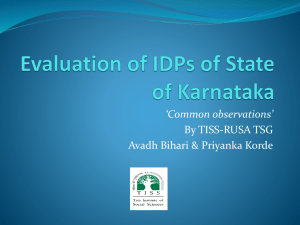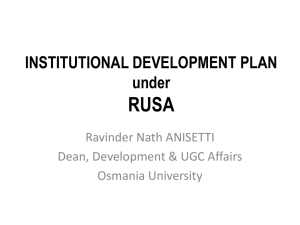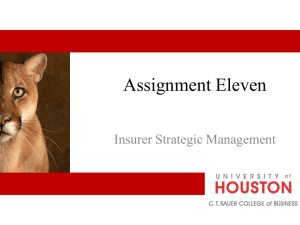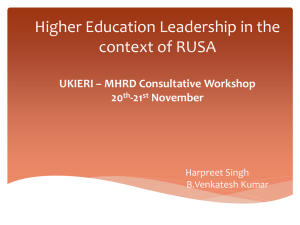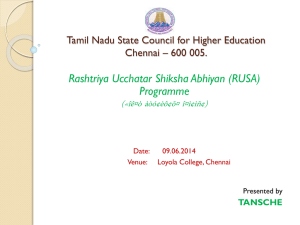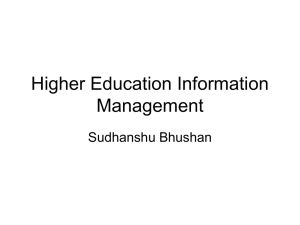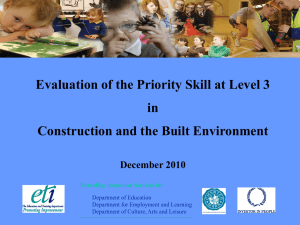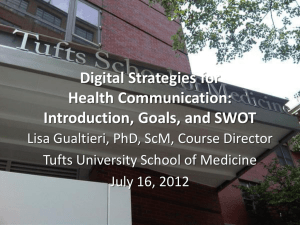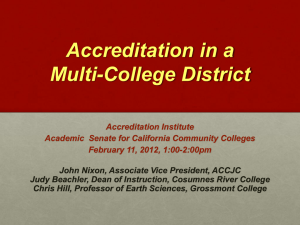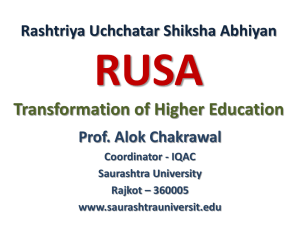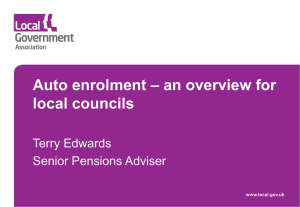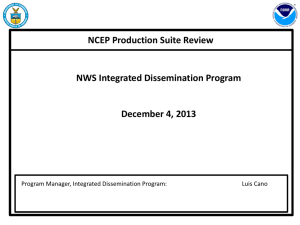PPT Presented at video Conference on 6-12
advertisement
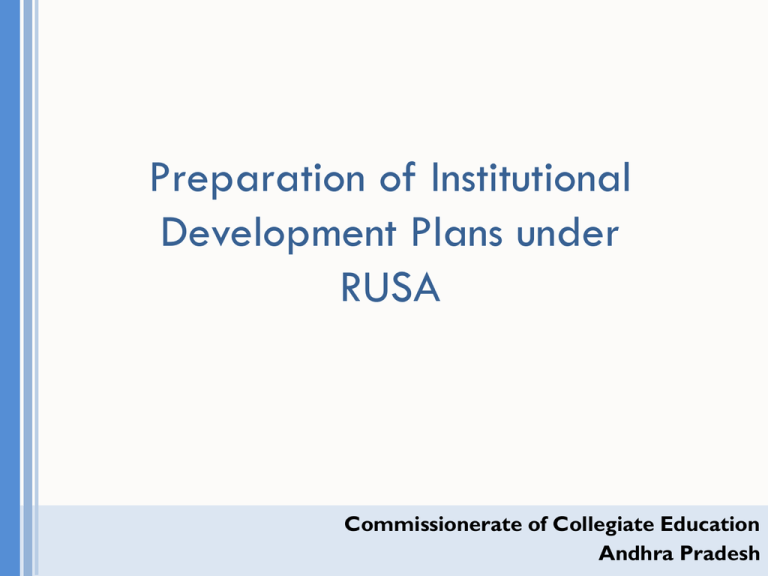
Preparation of Institutional Development Plans under RUSA Commissionerate of Collegiate Education Andhra Pradesh RUSA PROGRAMMATIC NORMS C1. Upgradation of autonomous colleges The college must have been in existence for at least 15 years. Accredited by NAAC with a grading not less than ‘A’ Preferably enjoy the status of College with Potential for Excellence (CPE) conferred by UGC. Robust internal governance structure ‐ Academic Council, Board of Studies/Research Councils and Finance Committees. Teaching programmes both in under‐graduate and post‐graduate courses. Credible research evidence by faculty through publications, undertaking research projects and guiding research students. Demonstrated inter‐disciplinary programmes in teaching and research. Healthy Student –Teacher ratio (15:1) Minimum existing enrollment of the college must be 2000 and proposed no. of students must be enough to sustain the institution as a university ( 4000). Upgradation of autonomous colleges Land already available with the college must be enough to support the additional enrolments and capacity (at least 25 acres, the university can grow horizontally as well as vertically) College should be able to function and be managed as a University., including the strength and experience of the administrative staff, the number of years that the college has been functioning, degree of autonomy it has enjoyed in past etc. The new university must address the affiliation issues of the existing universities in the State. i.e. it should be established as an affiliating university. Adequacy of academic, physical and technical infrastructure including library, hostel, equipment, ICT enabled services Conversion plan must include stage wise treatment of expansion in infrastructure, students, departments, administration, academic functions, research activities, assimilation of affiliated colleges etc. Autonomous Colleges seeking a University status must clearly specify; a) why the need for a University status, b) what innovations they are contemplating in academics and governance and, c) a plan in place to make innovations sustainable and scale up. C2. Creation of Cluster College Universities The State Higher Education Plan must justify the creation of Cluster University keeping in mind the following: The Participating colleges should: o Have been in existence for 15 years. o Have a NAAC rating of ‘Grade A’. o Have the potential to become a Multi‐Campus Cluster University. Cluster universities will be created by pooling the resources of 3 to 5 existing institutions which have adequacy of academic, physical and technical infrastructure in the college including library, hostel, equipment, ICT enabled services Robust internal governance structure ‐ Academic Council, Board of Studies, Research Councils and Finance Committees. Have a combination of colleges which are Autonomous status/ College with Potential for Excellence/Special Assistance received from reputed international or national funding agencies/’Centers of Excellence’ as identified by State Governments etc. Have teaching programme both in under‐graduate and post‐graduate courses or demonstrate ability to undertake post‐graduate programmes and demonstrate credible research evidence by some faculty members. Creation of Cluster College Universities Have a healthy Student – Teacher ratio (15:1) Have an existing combined enrolment of 2000 students and proposed enrolment no of no. students must be enough to sustain the institution as a university (4000). The physical proximity of the institutions (15‐20 km) should be such that they are able to share physical and human resources and not hamper student and faculty mobility The creation of the new cluster university must address critical gaps in spatial distribution of institutions across the State. Coverage of socially and economically backward groups must be ensured. The new university must address the affiliation issues of the existing universities in the State. C5. Upgradation to Model colleges Priority for proposals will be given on the basis of College Population Index, the districts with lower CPI will get preference. Amongst similarly placed districts, following criteria will be used to prioritize. o High proportion of socially and economically backward population o Low GER for female students o Low GER (SC/ST) o Sanctioned under the Model Degree College scheme o Antiquity o Special attributes/handicaps The Model Degree College must contain the following: o Girls Hostels and girls toilets o New hostels wherein 50% of capacity would be used for socially and economically weaker sections Converting existing buildings into fully disabled friendly environs (e.g. ramps, tactile pathways) Special facilities/equipments of disabled (e.g. computers, lab equipment’s) C7. Infrastructure Grants to Colleges Colleges will be divided in category A, B & C on the following basis: o No of Students o Antiquity of Institutions o % of SC/ST/OBC and Women students Priority will be given to colleges considering their accreditation status on the following basis of NAAC Grade received If not accredited then on the status of applying for accreditation The grant shall be utilised for critical infrastructural gaps which lead to immediate quality gains such as upgrading of libraries, laboratories, equipments, hostels and toilets etc. C9. Equity initiatives Enrolment of SC/ST/OBCs against specified percentages of reservations in the State The number of institutions that have or plan to create: Creation of equal opportunity cells Providing of remedial classes, language labs etc., Financial aid and scholarships for socially and economically backward students Equity and gender sensitization campaigns Innovative schemes/programmes to enhance equity and inclusion Preparation of Institutional Development Plan Institutional Basic Information (1.1-14.) Common for all institutes 1.1 Institutional Identity: Name of the Institution : Is the Institution approved by regulatory body? Furnish approval no. : Type of Institution : Govt. funded/Govt. aided/Private unaided/ Autonomous/Other Status of Institution University / Non-autonomous / Deemed University / Constituent Institution Name of Head of Institution and Project Nodal Officers :Yes/No : Autonomous Institute as declared by Name of Head of Institution and Project Nodal Officers Head and Nodal Officer Head of the Institution (Full time appointee) RUSA Institutional coordinator Nodal Officers for: Academic Activities Civil works engineering including Procurement Financial aspects Equity Assurance Implementation Plan Name Phone Number Mobile Number Fax Number E-mail Address Academic Information UG/PG/PhD programs offered in Academic year 200X-XX Whether Institution is Accredited? Grade When Accreditation Status of UG programs S. No Title programs of Level (UG, Duration PG, PhD) (Years) Year of Sanctioned Total starting annual student Intake strength Accreditation Status of PG programs Title of programs offered UG Whether eligible Whether "Applied for" Whether accredited as being for accreditation as on on 31st March 20XX? or not? 31st March 20xX? 1 Prof Asso Prof Asst Prof Total 2 C 8 R 9 R 11 Other Disciplines Engineering Disciplines C 10 C 12 R 13 C 14 of in R 7 Total Number contract faculty Position C 6 Other Disciplines Other Disciplines C R 4 5 Bachelor Degree of in R 3 Masters Degree Engineering Disciplines Doctoral Degree Total Number regular faculty Position Total Vacancies Present Status : Number in Position by Highest Qualification Engineering Disciplines Faculty Rank No. of Sanctioned Regular Posts Faculty Status (Regular/On-Contract Faculty as on March 31st, 20XX) 15= 16= 17 (3+5 (2- = +7+ 15) (4+6 9+ +8+ 11+ 10 13) +12 +14) Baseline Data (all data given for the following parameters to ALL disciplines) S. No 1 2 3 4 5 6 7 8 9 10 11 12 13 14 15 16 17 18 19 20 21 Parameters Total strength of students in all programs and all years of study in the year 20XX-1X Total women students in all programs and all years of study in the year 20XX-1X Total SC students in all programs and all years of study in the year 20XX-1X Total ST students in all programs and all years of study in the year 20XX-1X Total OBC students in all programs and all years of study in the year 20XX-1X Number of fully functional P-4 and above level computers available for students in the year 20XX-1X Total number of text books and reference books available in library for UG and PG students in the year 20XX-1X Student-teacher ratio % of UG students placed through campus interviews in the year 20XX-1X % of PG students placed through campus interviews in the year 20XX-1X % of high quality undergraduates (>75% marks) passed out in the year 20XX-1X % of high quality postgraduates (>75% marks) passed out in the year 20XX-1X Number of research publications in Indian refereed journals in the year 20XX-1X Number of research publications in International refereed journals in the year 20XX- 1X Number of patents obtained in the year 20XX-1X Number of patents filed in the year 20XX-1X Number of sponsored research projects completed in the year 20XX-1X The transition rate of students in percentage from 1st year to 2nd year in the year 20XX-1X for : (i)all students (ii)SC (iii) ST (iv) OBC IRG from students' fee and other charges in the year 20XX-1X (Rs. In lakh) IRG from externally funded R&D projects, consultancies in the year 20XX-1X (Rs. in l akh) Total IRG in the year 20XX-1X (Rs. in lakh) Total annual recurring expenditure of the institution in the year 20XX-1X (Rs. in lakh) 2.1 Executive Summary Of IDP Brief history Vision, Mission and Objectives of the institution Progress of the institutions Academic growth/achievements Problems encountered Action plan for future Significance of RUSA in contributing to growth of institution 2.2 SWOT Analysis Conducting SWOT analysis Strengths and weaknesses – Internal to organisation • Human resources - staff, board members, target population • Physical resources - your location, building, equipment (Does your building have a prime location?) • Financial - grants, funding agencies, other sources of income • Activities and processes - programs you run, systems you employ • Past experiences - building blocks for learning and success, your reputation in the community Opportunities and threats - External to organisation • Future trends in your field • The economy - local, national • Funding sources - foundations, donors, legislatures • Demographics - changes in the age, gender, culture of those in your catchment area • Physical environment • Legislation • Competition Strengths: Weaknesses • Infrastructure, Land, buildings, others • Lack of basic infrastructure like class • Student enrolment rooms • Academic programmes • Learning resources like labs, library • Faculty strength etc., • Stake holders support • Drop rate of students • Community involvement • Poor communication skills in English due • Equitable access as majority of student to lack of ICT enabled learning belong to marginalised sections resource like English Language Labs • Academic achievements (Pass percentage of students) • Research work done • Outreach programmes in neighbourhood • Employability training • Industry linkages if any Opportunities • Increased enrolment • Enhancement of employability • Arrest of dropout rate • Quality education • Scope to evolve as a premier institution in the area Threat • Persistent decline in enrolment leading to underutilisation of resources • Decline in quality of education negatively impacting academic growth 2.2 SWOT Analysis Include in the IDP Methodology used for SWOT o o Number and types of stakeholders involved in the SWOT analysis Documents referred to for gathering information for SWOT Analysis and information and data as collected o Provide data wherever possible Inferences derived with respect to strengths, weaknesses, opportunities and threats o Provide raw data and information gathered from SWOT as also the inferences gathered from the analysis 2.3 Strategic Plan Based on SWOT analysis, provide the "strategic plan" developed for institutional development o o o o o Vision and Mission Statements Introduction Summary of Challenges and Opportunities Summary of strengths and weaknesses List of strategic goals for the institution and brief description How the key activities proposed in the Institutional Development Proposal are linked with the results of SWOT Analysis 2.4 Specific Objectives and Expected Results State the specific objectives and expected results of your proposal (in terms of, "Institutional strengthening and improvements in employability and learning outcomes of graduates”) These objective and results should be linked to the SWOT analysis Possible objectives Increase in Academic quality reflected in quantifiable parameters like pass percentage Increase in enrolment Enhancement of employability Promotion of Research Minimising dropout rate 2.4 Action plan a) o o o b) o o c) o o o Improving employability of graduates Training on JKC platform Career counselling On-the job training Increased learning outcomes of the students Remedial Classes for slow learners Peer mentoring Obtaining autonomous institution status within 2 years Initiating the process by eligible institutions How much time the affiliating university will take in granting the autonomous institution status If there is no provision in the University Act, please indicate the State/University plan to amend the Act 2.4 Action Plan Achieving the targets of 60% of the eligible UG and PG programs accredited within two years of joining the Project and 100% accreditation obtained and applied for by the end of the Project of the eligible UG and PG programs c) o Approaching NAAC for accreditation o Institutions can provide for time frame action plan to overcome the hurdles that can be faced in the process of accreditation like o Availability of qualified teaching faculty o Infrastructure facility, laboratory facilities o Teacher student ratio o R&D, Consultancy Projects etc. 2.4 Action Plan d) Implementation of academic and non-academic reforms o Academic audit, Academic Performance Indicators (API) and AADPI for Principals o RUSA 4.8.11 e) o f) o o Methods of appointing Institution Heads o Rationalize the size and composition of decision making bodies (Executive Council, Academic Council, Senate) o Human Resource policy (Faculty appointment and appointment non academic staff ) o Process re-engineering : Finance facilitation and approvals Improving interaction with industry Mapping of industry in that region/area, Identifying skill-set required and imparting through JKCs Enhancement of research and consultancy activities Explore potential of Faculty, Research infrastructure 2.5 Action Plan for finishing school o o o o o o o JKC – offering more number of skill based training programmes on JKC platform Confirmation to the intake percentages specified for SC, ST, OBC as specified Stipends and scholarships given- Boarding grants/ educational scholarships etc. Creation of book banks Appointment of active proctor/faculty advisor for newly entering students from SC/ST/OBC backgrounds Remedial classes especially before examinations/ Student Academic Support Program Language Labs for improving communication skills 2.6 Action Plan for Strengthening PG Programmes o Feedback from students regarding PG Courses needed o Approaching the affiliating authorities to get it sanctioned o Creation of infrastructure o Proposal of new programs at the PG level as justified by the labour market o Fill vacancies (if any) in UG& PG programmes and increase the enrolment in PG education through provision of Teaching and Research Assistantship. University and concerned 2. 7 Training Needs Analysis and Faculty Development Plan Provide summary of TNA Faculty development Plan for 18 months o Training programmes conducted for teaching staff on various platforms o Details of lecturers nominated for Orientation and Refresher courses and workshops conducted by Academic Staff Colleges of Universities – others 2.8 Action Plan for Training of technical and other staff o Training conducted for non-teaching staff on DRC/JKC platform on computer skill and other areas 2.9 Relevance and Coherence of IDP Describe the relevance and coherence of IDP with State’s Industrial/ Economic Development Plan o Refer to State Annual Plan (2013-14) o AP Approach paper to 12th FYP o State Industrial Investment Promotion Policy 2.10 Participation of Departments/Faculty Participation of Department/Faculty in the IDP preparation – Briefing about institutional level committees and involvement of faculty in preparation of IDP 2.11 Institutional Project implementation Institutional Project implementation – Institution – level monitoring Committees to implement the project 1 Infrastructure 1. Modernization and strengthening of laboratories 2. Establishment of new laboratories for existing UG and PG programs and for new PG programs 3. Modernization of classrooms 4. Updation of Learning Resources 5. Procurement of furniture 6. Establishment/Upgradation of Central and Departmental Computer Centers 7. Modernization/improvements of supporting departments 8. Modernization and strengthening of libraries and increasing access to knowledge resources 9. Refurbishment (Minor Civil Works) 2 Research and development support Providing Teaching and Research Assistantships to increase enrolment in existing and new PG programmes in Engineering disciplines Provision of resources for research support Enhancement of R&D and institutional consultancy activities 3 Faculty Development Support Faculty and Staff Development (including faculty qualification upgradation, pedagogical training, and organising/participation of faculty in workshops, seminars and conferences) for improved competence based on TNA 4 Institutional reforms Technical assistance for procurement and academic activities Institutional management capacity enhancement 5 Academic support Creation of new departments/courses Enhanced Interaction with Industry Student support activities 6 Others TOTAL THANK YOU
